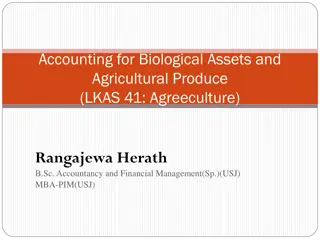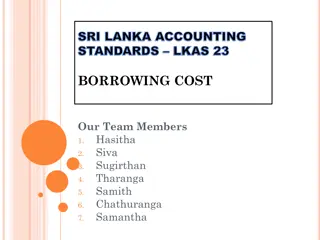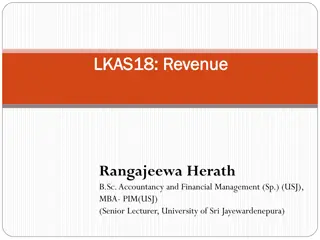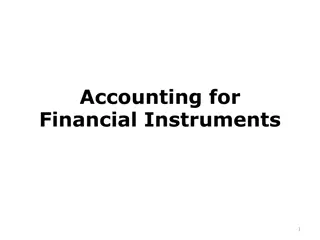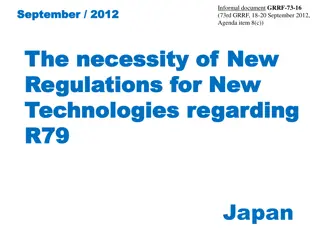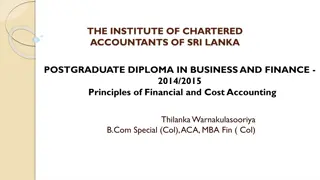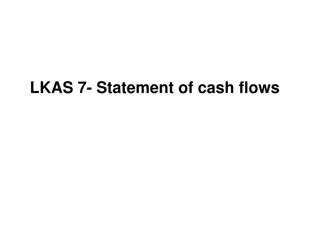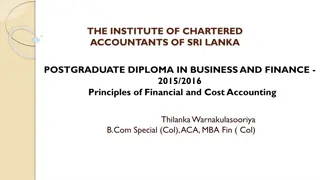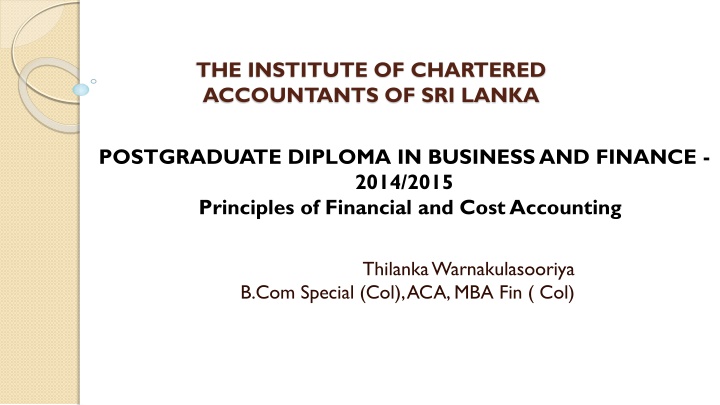
Principles of Financial and Cost Accounting in Business
Learn about accounting policies, changes in estimates, and errors in financial reporting. Understand the importance of consistency in applying accounting policies and the factors governing changes. Discover the process of applying changes in accounting policies retrospectively for accurate financial statements.
Download Presentation

Please find below an Image/Link to download the presentation.
The content on the website is provided AS IS for your information and personal use only. It may not be sold, licensed, or shared on other websites without obtaining consent from the author. If you encounter any issues during the download, it is possible that the publisher has removed the file from their server.
You are allowed to download the files provided on this website for personal or commercial use, subject to the condition that they are used lawfully. All files are the property of their respective owners.
The content on the website is provided AS IS for your information and personal use only. It may not be sold, licensed, or shared on other websites without obtaining consent from the author.
E N D
Presentation Transcript
THE INSTITUTE OF CHARTERED ACCOUNTANTS OF SRI LANKA POSTGRADUATE DIPLOMA IN BUSINESS AND FINANCE - 2014/2015 Principles of Financial and Cost Accounting Thilanka Warnakulasooriya B.Com Special (Col), ACA, MBA Fin ( Col)
LKAS 8 Accounting Policies, Changes in Accounting Estimates and Errors:
Scope Selecting & application of accounting policies The accounting treatment for changes in accounting policies & accounting estimates Correction & accounting for correction of errors occurred in previous periods. Definitions
What are Accounting Policies? These are: Specific principles; Bases; Conventions; Rules; Practices; These are applied in preparing and presenting financial statements.
Accounting policies are essential for a proper understanding of the information contained in the financial statements prepared by the management of an entity. An entity should clearly outline all significant accounting policies it has used in preparing the financial statements
Consistency of Accounting Policies Once selected, accounting policies must be applied consistently for similar transactions, other events, and conditions unless a Standard or Interpretation specifically otherwise requires or permits categorization of items for which different policies may be appropriate
Factors governing changes in Accounting Policies Once selected, an accounting policy may be changed only if the change Is required by a Standard or an Interpretation. Results in financial statements providing reliable and more relevant information.
Applying changes in Accounting Policies Retrospective Application Retrospective application is applying a new accounting policy to transactions, conditions as if that policy had always been applied events and How to do? Restate the corresponding amounts presented in financial statements if the new policy had always been applied. Adjusted the retained earnings prior to the earliest period against the opening balance of retained earnings.
i.e. Cool Pvt Ltd changed its accounting policy in 2014 with respect to the valuation of inventories. Up to 2013, inventories were valued using a weighted-average cost (WAC) method. In 2014 the method was changed to first-in, first-out (FIFO), as it was considered to more accurately reflect the usage and flow of inventories in the economic cycle. The impact on inventory valuation was determined to be At March 31, 2012: At March 31, 2013: At March 31, 2014: an increase of 10,000 an increase of 15,000 an increase of 20,000 The statements of comprehensive income prior to adjustment are 2013-14 2012-13 Revenue Cost of sales Gross profit Administration costs Selling and distribution costs Net profit 250,000 100,000 150,000 60,000 25,000 65,000 200,000 80,000 120,000 50,000 15,000 55,000 Present the change in accounting policy in the Statement of Comprehensive Income and the Statement of Changes in Equity in accordance with the requirements of LKAS 8
Changes in Accounting Estimates As a result of the uncertainties inherent in the business activities many items in the FS cannot be measured with precision but only can be estimated. Examples - bad debt provisions - inventory obsolescence - useful life/ pattern of consumption of depreciable assets - warranty obligations - An Estimate need a revision, if a change occurs in the circumstances on which the estimate was made. Applied prospectively - in current (and future) periods 10 notes reference - page 6.9
Changes in Accounting Estimates (Prospective Adjustment!!) Machine original cost of 200,000 - estimated useful life 10 years, and residual value of nil. The annual straight-line depreciation charge will be 20,000 per annum and the carrying amount after three years will be 140,000. In year 4, as a result of changes in market conditions, the remaining useful life is estimated to be only three years; then the depreciation charge in that year (and in the next two years) will be 140,000/3 = 46,667. There should be no change to the depreciation charged for the past three years. The effect of the change (an increase in the annual depreciation charge from 20,000 to 46,667) in the current year, and the next two years, should be disclosed.
Prior period errors Prior period error an omission or misstatement in previously reported financial statements from failing to use/misuse of reliable information that Was available when F/S were authorized, and Could reasonably be expected to have been used in preparing those F/S e.g., arithmetic mistakes, mistakes in applying accounting policies, oversights, misrepresentation of facts, fraud
Prior period errors accounting treatment Retrospective Restatement This is the correction, identification, measurement and disclosure amounts of elements of FS as if prior error had never of occurred. Restate comparatives Adjust opening balance of assets, liabilities and equity (if necessary) Disclose for each line item affected i.e Refer Annexure

